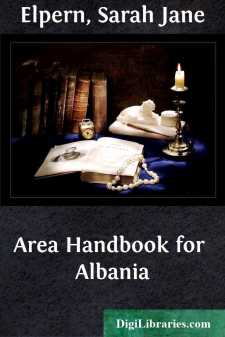Categories
- Antiques & Collectibles 13
- Architecture 36
- Art 48
- Bibles 22
- Biography & Autobiography 813
- Body, Mind & Spirit 142
- Business & Economics 28
- Children's Books 15
- Children's Fiction 12
- Computers 4
- Cooking 94
- Crafts & Hobbies 4
- Drama 346
- Education 46
- Family & Relationships 57
- Fiction 11828
- Games 19
- Gardening 17
- Health & Fitness 34
- History 1377
- House & Home 1
- Humor 147
- Juvenile Fiction 1873
- Juvenile Nonfiction 202
- Language Arts & Disciplines 88
- Law 16
- Literary Collections 686
- Literary Criticism 179
- Mathematics 13
- Medical 41
- Music 40
- Nature 179
- Non-Classifiable 1768
- Performing Arts 7
- Periodicals 1453
- Philosophy 64
- Photography 2
- Poetry 896
- Political Science 203
- Psychology 42
- Reference 154
- Religion 513
- Science 126
- Self-Help 84
- Social Science 81
- Sports & Recreation 34
- Study Aids 3
- Technology & Engineering 59
- Transportation 23
- Travel 463
- True Crime 29
Area Handbook for Albania
Description:
Excerpt
PREFACE
Albania, or, as it proclaimed itself in 1946, the People's Republic of Albania, emerged from World War II under the control of the local Communist movement, which later adopted the name Albanian Workers' Party. The most remarkable feature of Albanian life during the 1960s was the rigid alignment with Communist China in that country's ideological struggle with the Soviet Union. In mid-1970 the country continued to be Communist China's only European ally and its mouthpiece in the United Nations. Propaganda broadcasts in several languages, extensive for such a small, undeveloped country, continued to emanate from the capital city of Tirana, constantly reiterating the Chinese Communist line and making Radio Tirana sound like an extension of Radio Peking.
Albania's most notable tradition from ancient times has been one of foreign domination. Brief periods of independence have been overshadowed by long centuries of subjection to alien rule. Foreign rulers never seemed able or willing to subject the Albanian peasants to the complete authority of a central government. Throughout their history Albanians, protected by the remoteness of their mountain villages, often enjoyed a measure of autonomy even though they lacked national independence. The foreign domination plus the limited autonomy developed in the people a spirit of fierce independence and a suspicion of neighboring states that might have designs on their territorial integrity.
Militarily undeveloped but unwilling to submit to partition by its neighbors, Albania has held on precariously to autonomy since World War II by becoming a client state—first to Yugoslavia, then to the Soviet Union, and then to Communist China. In all three relationships Albania has maintained its independence but it has not been able to establish itself as a viable economic entity.
The Area Handbook for Albania seeks to present an overview of the various social, political, and economic aspects of the country as they appeared in 1970. The leaders of the Communist Party have gone to extremes to maintain an aura of secrecy about their nation and their efforts to govern it. Material on Albania is scanty and some that is available is not reliable but, using their own judgments on sources, the authors have striven for objectivity in this effort to depict Albanian society in 1970.
The spelling of place names conforms to the rulings of the United States Board on Geographic Names, with the exception that no diacritical marks have been used in this volume. The metric system has been used only for tonnages.
1. COUNTRY: People's Republic of Albania (Albania). Called Shqiperia by Albanians. A national state since 1912. Under Communist control after 1944.
2. GOVERNMENT: Functions much like Party-state model of Soviet Union. Constitution designates People's Assembly as highest state organ; its Presidium conducts state affairs between Assembly sessions. People's Council highest organ at district and lower echelons. Communist Party (officially, the Albanian Workers' Party) organizations parallel government organizations and control them from national to local levels. Party members hold all key positions in government.
3. SIZE AND LOCATION: Area, 11,100 square miles; smallest of the European Communist states. Extends 210 miles from southern to northern extremities; 90 miles on longest east-west axis. Bordered on north and east by Yugoslavia; on southeast and south by Greece; and on west by Adriatic and Ionian seas.
4. TOPOGRAPHY: A narrow strip of lowland borders Adriatic Sea; remainder of country is mountainous and hilly, intersected by streams that flow in westerly or northwesterly direction. Terrain is generally rugged.
5. CLIMATE: Unusually varied. Coastal lowlands have Mediterranean-type climate. Inland fluctuations common, but continental influences predominate. Annual precipitation is 40 to 100 inches according to area; highly seasonal; summer droughts common. Temperatures vary widely because of differences in elevation and the changes in prevailing Mediterranean and continental air currents.
6. ADMINISTRATIVE DIVISIONS: Twenty-six districts. Economic and social factors played important role in shaping delineations. Control and direction is from Tirana.
7. POPULATION: Estimated 2.1 million in January 1970. Growth unusually rapid; at 1970 rate, would double in twenty-six years. Two-thirds live in rural areas. Inhabitants are 97-percent ethnic Albanian. About 106 males per 100 females.
8. LABOR: In 1967 the working-age population numbered about 932,000, of which approximately 745,000 were employed. About 66.7 percent were in agriculture; 14.1 percent in industry; 5.4 percent in construction; and 13.8 percent in trade, education, health, and others.
9. LANGUAGE: Albanian spoken by everyone. Some of the 3-percent minority use tongue of country of family origin as a second language.
10. EDUCATION: Nearly all persons under age forty are literate, according to Albanian statistics. Communist ideas and principles emphasized with strict controls by centralized authority. Production of capabilities and skills required for modernization and industrialization considered to be a major goal.
11. RELIGION: Organized religion destroyed by government action in 1967....


